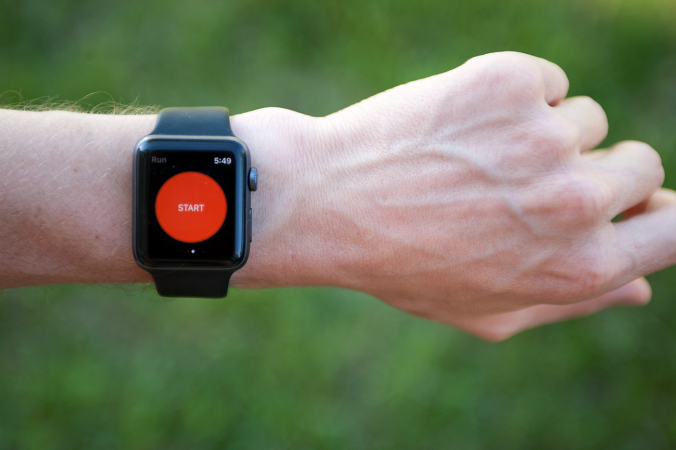I have been an avid Apple fan for years, but I have two Apple Watches currently gathering dust on my dresser.
The majority of my ecosystem is within Apple, so when Apple announced the first-generation Apple Watch a couple of years ago, I knew I’d have one on day one. It had issues, but I enjoyed being an early adopter and finding uses for Apple’s new wearable.
As a running watch, the first-generation Apple Watch required an iPhone, which was less than ideal. When Apple announced the Apple Watch 2 – and its built-in GPS – it sounded great; I could load music onto my watch, leave my phone at home, and get in a quick run. All with just once device.
Over the last few months the Apple Watch has become even more intriguing. Third-party developers, such as Strava, have released major updates to their popular apps that take advantage of the built-in GPS. Overcast, a popular podcast player, has added the ability to download and play podcasts directly on the Apple Watch, a feature that Apple hasn’t enabled on its own Apple Podcast app.
But, as great as the watch has become, I kept asking myself if it really meets my needs.
For instance, it should be a great daily watch because it of its ability to receive and triage notifications. But to receive those notifications you have to have a cellphone signal, but while I am at work, I do not have a cellphone signal. That leaves nine hours a day that I do not get the benefits of the smart watch.
And there are a few more shortcomings …
The Battery:
Apple’s website states the Apple Watch 2 will get 18 hours of battery life. With GPS running, you can expect approximately five hours of battery.
With that kind of battery life, the Apple Watch is great for everyday use and short runs. If you need something for daily wear and you are only working out or running for an hour or so a day, you’ll have no problem with this watch. But, if you need to use the GPS for an extended amount of time then you’ll either become an expert at battery management or this watch will not work for you.
I am firmly in the second category.
The Apple Watch is meant to be charged daily, which I have never found to be too inconvenient. However, this watch will not work for long mountain runs or anything that will take more that five hours. So, while I have always loved the idea of running with my Apple Watch, I found myself always switching to my Garmin when it came time to log some miles.
Activity Tracking and the Ecosystem:
The Apple Watch is a great activity tracker but it has some shortcomings.


The first has to deal with sleep tracking. While there are awesome third-party apps that will track sleep, such as Autosleep, Apple does not have a built-in sleep tracking feature. The third-party apps will allow you to get an idea of your sleep, but it just feels kind of janky and adds yet another app you have to manage.
The second has to deal with my need to run with a different watch. While the Garmin data will sync via the Health App, not everything always carries over. For example, the mileage logged on the Garmin will show up in the Apple Activities app, but not the steps. I can log 30 miles and it will show me having taken just 2,000 steps instead of the 50,000+ I actually have. Or worse, on some occasions the Activities app will not sync the Garmin data, and despite running 100 miles, my Move streak in Apple’s Activity app will be broken.
Sweat/rain and the touch controls:
Touch screens are amazing. Unless of course your fingers or the surface of the device are wet.
The Apple Watch is no exception. Running with the Apple Watch in the rain or on a hot, sweaty day can create some aggravation. When I finish my workout, swiping right on the screen should give me the opportunity to hit a digital button to end and then save a run. However, if the surface or my finger is wet, I end up swiping repeatedly. While it may eventually work, I get irritated that my data isn’t as accurate. This is especially true if I lose 15 to 30 seconds on a tempo run.
Heart Rate Monitoring:
While the accuracy for the Apple Watches heart rate (HR) monitor are well known, it tends to be less accurate during a workout. Sara and I have frequently registered a HR over over 170 beats per minute while running at a casual, conversational pace. In a similar situation with my Garmin watch paired with a Garmin HRM Run strap, I will register in the 130s.
Hello Garmin Fenix 5!

Garmin Fenix 5 still has a lot of screen real estate, but in a smaller footprint than its predecessor.
Because of everything I’ve covered above, I’ve put my Apple Watch aside for the next few weeks and am trying out the new Garmin Fenix 5. There will of course be a lengthy review of the Fenix 5 after we run the Bryce Canyon 100 in June. And while I hope that the Garmin watch and ecosystem give me everything I want, I will be holding onto the Apple Watch just in case Apple adds something that I just can’t live without.
